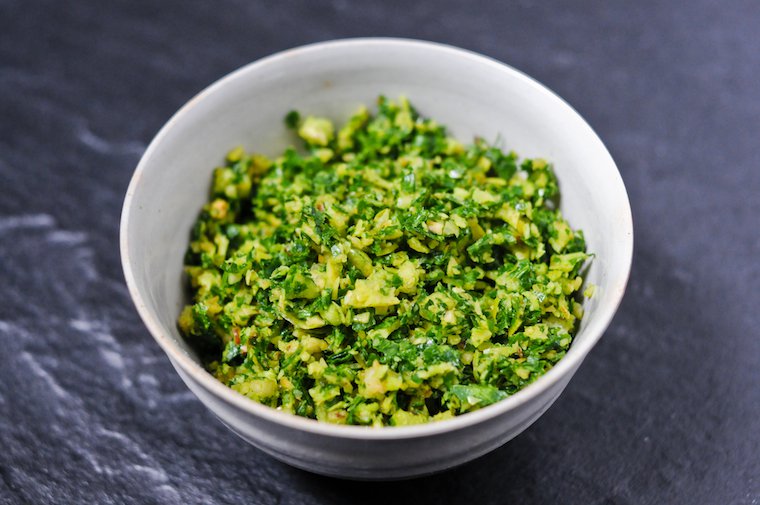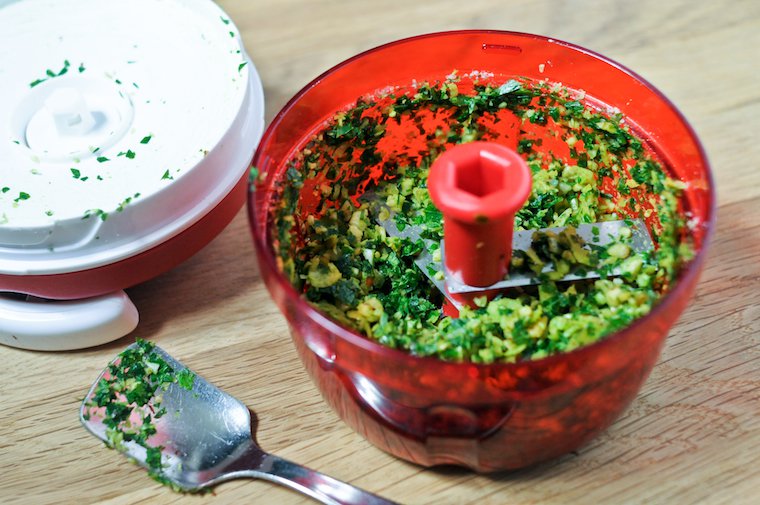Buy Clotilde's latest book, The French Market Cookbook!
Image may be NSFW.
Clik here to view.
Gremolata is an Italian condiment I adore — a simple, and quickly assembled mix of flat-leaf parsley, lemon zest, and garlic, chopped finely.
It is most traditionally associated with osso buco, and indeed it works wonders (wonders, I tell you!) on any slow-roasted or braised meat dish, sprinkled on just before serving. It tastes fresh and clean, and cuts right through the richness of a stew, brightening the overall flavors by several notches.
But it would be a pity to restrict gremolata to this classic use. You can also:
– stuff it underneath the skin of chicken before roasting (I detail this technique in my post on salt-crusted chicken),
– sprinkle it over roasted eggplant, mushrooms, carrots, or cauliflower,
– use it to garnish soups, especially winter squash soups,
– add it to salads (especially lentil salads) and sandwiches,
– toss it with pasta, white beans, or small waxy potatoes,
– add breadcrumbs and a little bit of oil to form a paste, and spread on fish fillets before baking,
– use it to season steamed mussels or grilled sardines,
– fold it into ricotta or fresh goat cheese to top crostini…
The list goes on and on, so you would do well to mix a big batch whenever you have the ingredients on hand, and keep it in the fridge for a couple of days to add to your cooking and spark new ideas.
And just as the uses are multiple, so too are the possible variations on this glorious trinity: you can use parsley in combination with another fresh herb (I do recommend keeping at least a portion of parsley to retain that flavor thumbprint), you can mix and match citrus zests (orange is also a classic, but grapefruit or bergamot would be inspired twists), and you can add a fillet of anchovy or a few black olives to replace the salt.
I myself like to add roasted hazelnuts to my gremolata for a nutty note, an idea that comes from genius cook Sonia Ezgulian by way of the gremolata bowls she placed on every table when she was a guest chef at Café Pleyel.
And part of my pleasure in making gremolata is that it gives me a chance to use the very nifty hand-cranked mini-chopper I got from Tupperware years ago*. It works a bit like an old-school salad spinner, with a handle and a cord that sets in motion a rotating set of blades (see below). I like the retro-ness of it, and find it is just the thing to produce a gremolata that’s chopped tiny, but not completely ground. Also, handy in the event of a blackout!
Join the conversation!
Do you make gremolata? What’s your version like, and what do you use it on?
Image may be NSFW.
Clik here to view.
*Disclosure: I received this mini chopper for free from the press services of Tupperware France a few years ago, with no obligation to write about it, and no compensation if I ever decided to. All opinions expressed are my own.
Clik here to view.

Have you tried this? Share your pics on Instagram!
Please tag your pictures with #cnzrecipes. I'll share my favorites!
Ingredients
- the leaves from 1 small bunch flat-leaf parsley, about 15 grams or 1 cup
- the zest of 1 large organic lemon, peeled into strips with a vegetable peeler
- 1 large clove garlic
- about 20 hazelnuts, optionally roasted
- 1/4 teaspoon fine sea salt
- freshly ground black pepper
Instructions
- Place all the ingredients in the bowl of a food processor and process in short pulses until finely chopped, but not puréed: you should still be able to make out the individual flecks of citrus zest and parsley. Alternatively, you can chop the ingredients by hand.
- Taste and adjust the seasoning. Cover and refrigerate until ready to serve, up to 2 days.
The post Hazelnut Gremolata Recipe appeared first on Chocolate & Zucchini.